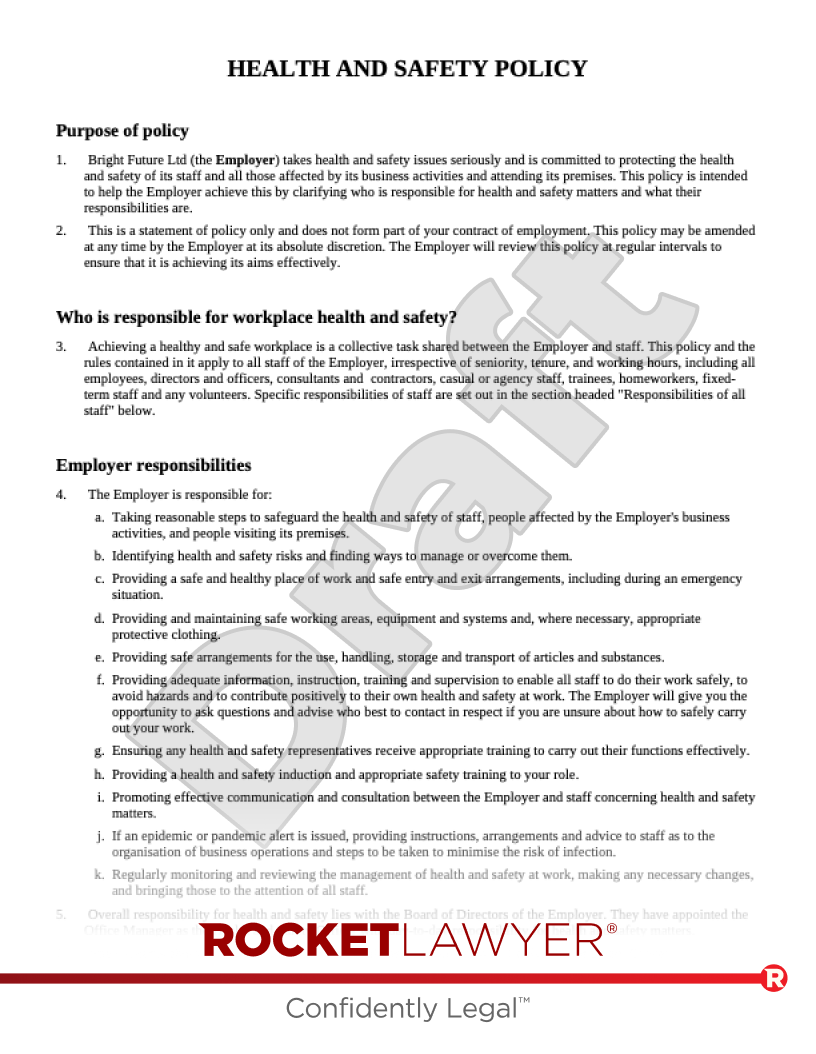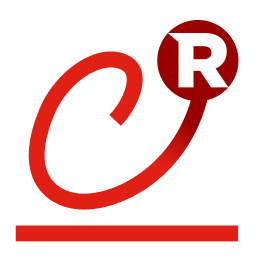MAKE YOUR FREE Health and Safety Policy

What we'll cover
What is a Health and Safety Policy?
Health and Safety Policies set out how an employer ensures that their workplace is safe to work in. They demonstrate how a business complies with its legal health and safety obligations. A Health and Safety Policy outlines individuals’ responsibilities and important procedures relating to health and safety at work.
Having a written Health and Safety Policy is a legal requirement for organisations with five or more employees.
When should I use a Health and Safety Policy?
Use this Health and Safety Policy:
-
to comply with the legal requirement to have a written Health and Safety Policy if you have five or more employees
-
or to demonstrate your compliance with the obligation to have a policy on health and safety (written or otherwise) regardless of how many employees you have
-
-
to help meet your legal duty of care in relation to workers' and visitors’ (eg customers’) health and safety
-
to ensure that employees are clear about their health and safety obligations and rules
-
for staff based in England, Wales or Scotland
Sample Health and Safety Policy
The terms in your document will update based on the information you provide
HEALTH AND SAFETY POLICY
Purpose of Policy
- (the Employer) takes health and safety issues seriously and is committed to protecting the health and safety of its staff and all those affected by its business activities and attending its premises. This Policy is intended to help the Employer achieve this by clarifying who is responsible for health and safety matters and what their responsibilities are.
- This is a statement of policy only and does not form part of your contract of employment. This Policy may be amended at any time by the Employer at its absolute discretion. The Employer will review this Policy at regular intervals to ensure that it is achieving its aims effectively.
Who is Responsible For Workplace Health and Safety?
- Achieving a healthy and safe workplace is a collective task shared between the Employer and staff. This Policy and the rules contained in it apply to all staff of the Employer, irrespective of seniority, tenure, and working hours, including all employees, directors and officers, consultants and contractors, casual or agency staff, trainees, homeworkers, fixed-term staff and any volunteers. Specific responsibilities of staff are set out in the section headed "Responsibilities of all staff" below.
Employer Responsibilities
- The Employer is responsible for:
- Taking reasonable steps to safeguard the health and safety of staff, people affected by the Employer's business activities, and people visiting its premises.
- Identifying health and safety risks and finding ways to manage or overcome them.
- Providing a safe and healthy place of work and safe entry and exit arrangements, including during an emergency situation.
- Providing and maintaining safe working areas, equipment and systems and, where necessary, appropriate protective clothing.
- Providing safe arrangements for the use, handling, storage and transport of articles and substances.
- Providing adequate information, instruction, training and supervision to enable all staff to do their work safely, to avoid hazards and to contribute positively to their own health and safety at work. The Employer will give you the opportunity to ask questions and advise who best to contact in respect if you are unsure about how to safely carry out your work.
- Ensuring any health and safety representatives receive appropriate training to carry out their functions effectively.
- Providing a health and safety induction and appropriate safety training to your role.
- Promoting effective communication and consultation between the Employer and staff concerning health and safety matters.
- If an epidemic or pandemic alert is issued, providing instructions, arrangements and advice to staff as to the organisation of business operations and steps to be taken to minimise the risk of infection.
- Regularly monitoring and reviewing the management of health and safety at work, making any necessary changes, and bringing those to the attention of all staff.
- Supporting staff mental health by, as appropriate:
- Implementing workplace modifications to protect staff mental health and improving conditions for all staff.
- Providing a less stressful work atmosphere by altering the workplace where necessary.
- Allowing working from home where appropriate.
- Providing emotional support to staff in or outside of the workplace (e.g. by arranging professional mental health support).
- Overall responsibility for health and safety lies with . They have appointed as the Health and Safety Officer with day-to-day responsibility for health and safety matters.
- Any concerns about health and safety matters should be communicated to the Health and Safety Officer.
Responsibilities of All Staff
General Staff Responsibilities
- All staff must:
- Take reasonable care for their own health and safety and that of others who may be affected by their acts or omissions.
- Co-operate with the Health and Safety Officer and the Employer generally to enable compliance with health and safety duties and requirements.
- Comply with any health and safety instructions and rules, including instructions on the safe use of equipment.
- Keep health and safety issues in the front of their minds and take personal responsibility for the health and safety implications of their own acts and omissions.
- Keep the workplace tidy and hazard-free.
- Report all health and safety concerns to the Health and Safety Officer promptly, including any potential risks, hazards or malfunctioning of equipment, however minor or trivial they may seem.
- Co-operate in the Employer's investigation of any incident or accident which either has led to injury or which, in the Employer's opinion, could have led to injury.
Staff Responsibilities Relating to Equipment
- All staff must:
- Use equipment as directed, following any instructions given by representatives of management or contained in any written operating manual or instructions for use, and adhering to any relevant training.
- Report any fault with, damage to, or concern about any equipment (including health and safety equipment) or its use to the Health and Safety Officer, who is responsible for maintenance and safety of equipment.
- Ensure that health and safety equipment is not interfered with.
- Not attempt to repair equipment unless suitably trained and authorised.
Staff Responsibilities Relating to Accidents and First Aid
- All staff must:
- Promptly report any accident at work involving personal injury, however trivial, to the Health and Safety Officer so that details can be recorded in the Accident Book. They must also cooperate with any associated investigation.
- Familiarise themselves with the details of first aid facilities and trained first aiders, which are
- If an accident occurs, dial and ask for the duty first aider, giving name, location and brief details of the problem.
- The Health and Safety Officer is responsible for investigating any injuries or work-related illnesses, preparing and keeping accident records, and for submitting reports under the Reporting of Injuries, Diseases and Dangerous Occurrences Regulations 2013 (RIDDOR), where required.
Staff Responsibilities Relating to Emergency Evacuation and Fire
- All staff must:
- Familiarise themselves with the instructions about what to do if there is a fire which.
- Ensure they are aware of the location of fire extinguishers, fire exits and alternative ways of leaving the building in an emergency.
- Comply with the instructions of firewardens if there is a fire, suspected fire or fire alarm (or a practice drill for any of these scenarios).
- Co-operate in fire drills and take them seriously (ensuring that any visitors to the building do the same). Fire drills will be held at least once every 12 months.
- Ensure that fire exits or fire notices or emergency exit signs are not obstructed or hidden at any time.
- Notify the Health and Safety Officer immediately of any circumstances (for example, impaired mobility) which might hinder or delay evacuation in a fire. This will allow the Health and Safety Officer to discuss a personal evacuation plan for you, which will be shared with the fire wardens and colleagues working near to you.
- On discovering a fire, all staff must:
- Immediately trigger the nearest fire alarm and, if time permits, call and notify the location of the fire.
- Attempt to tackle the fire ONLY if they have been trained or otherwise feel competent to do so. Nominated members of staff will be trained in the use of fire extinguishers.
- On hearing the fire alarm, all staff must:
- Remain calm and immediately evacuate the building, walking quickly without running, and following any instructions of the fire wardens.
- Leave without stopping to collect personal belongings.
- Stay out of any lifts.
- Remain out of the building until notified by a fire warden that it is safe to re-enter.
- The Health and Safety Officer is responsible for ensuring that fire risk assessments take place, that changes are made where required, and for making sure there are regular checks of fire extinguishers, fire alarms, escape routes, signage and emergency lighting.
Risk Assessments and Manual Handling
- Risk assessments are essentially a careful examination of what in the workplace could cause harm to people. The Employer will assess any risks and consider measures to best minimise any risk. The Employer will carry out general workplace risk assessments when required or as reasonably requested by staff. Managers must ensure that any necessary risk assessments take place and the resulting recommendations are implemented. The Health and Safety Officer is responsible for workplace risk assessments and any measures to control risks.
- Personal Protective Equipment (PPE) is provided where risks cannot be otherwise effectively controlled.
- Guidance on manual handling (for example, lifting and carrying heavy objects) can be obtained from the Health and Safety Officer and where necessary training will be provided by the Employer, but the Employer will try to minimise or avoid the need for manual handling where there is a risk of injury.
Non-Compliance With Health and Safety Rules
- Any breach of health and safety rules or failure to comply with this Policy will be taken very seriously and is likely to result in disciplinary action against the offender, in accordance with the Employer's Disciplinary Policy, up to and including immediate dismissal.
Attribution
- This Health and Safety Policy was created using a document from Rocket Lawyer (https://www.rocketlawyer.com/gb/en).
About Health and Safety Policies
Learn more about making your Health and Safety Policy
-
How to make a Health and Safety Policy
Making a Health and Safety Policy online is simple. Just answer a few questions and Rocket Lawyer will build your document for you. When you have all of the details prepared in advance, making your document is a quick and easy process.
To make your Health and Safety Policy you will need the following information:
Parties and responsibilities
-
What is the employer's name?
-
Who holds overall responsibility for workplace health and safety? This may be a named individual, a committee, or the board of directors.
-
Who has day-to-day responsibility for health and safety? This person is known as the ‘Health and Safety Officer’.
Training
-
What will employees receive training on?
First aid
-
Are details of first aid facilities and personnel available:
-
On a notice board? If so, where can the notice board be found?
-
From the Health and Safety Officer?
-
-
If there is an accident requiring first aid attention, which internal phone number should be called?
Fire
-
Are instructions for staff on what to do if there is a fire available:
-
On a notice board? If so, where can the notice board be found?
-
From the Health and Safety Officer?
-
-
If there is a fire, who within the business should staff contact?
Display screen equipment (DSE)
-
Does your business use DSE? If so:
-
Is there separate guidance on the use of DSE and where can this be found?
-
Who is responsible for carrying out workstation assessments and providing information about DSE-related health and safety?
-
Should employee eye tests be arranged by the employer or the employee?
-
Should eye tests and any glasses required for DSE use be paid for by the employee (who will be reimbursed by the employer) or using a voucher scheme?
-
If a voucher scheme is used:
-
Who needs to approve requests for access to the voucher scheme?
-
Who is responsible for distributing vouchers?
-
Can employees access the voucher request form online?
-
-
If the employee should pay and be reimbursed:
-
How much does the employer contribute towards eye tests?
-
How much does the employer contribute towards glasses?
-
Who is responsible for reimbursement claims forms?
-
Can employees also access the reimbursement claims form online?
-
-
What DSE-related information and training do you provide for employees?
-
-
Common terms in a Health and Safety Policy
Health and Safety Policies outline how employers comply with the legal duty to ensure their workforce’s health and safety. To do so, this Policy includes the following provisions:
Purpose of Policy
This section provides a brief overview of the Health and Safety Policy and why it is being adopted. It also highlights the fact that the Policy does not form part of any employment contracts and can, therefore, be changed by the employer at their discretion.
Who is responsible for workplace health and safety?
This section sets out that ensuring workplace health and safety is a collective task shared between the employer and all staff members.
Employer responsibilities
This section sets out the employer’s specific obligations and responsibilities with regard to workplace health and safety. It also sets out who has overall responsibility for workplace health and safety and who has day-to-day responsibility (ie who is the Health and Safety Officer).
Responsibilities of all staff
This section sets out the responsibilities staff members have with regard to ensuring health and safety in the workplace. These include:
-
general staff responsibilities
-
staff responsibilities relating to equipment
-
staff responsibilities relating to emergency evacuation and fire
Risk assessments and manual handling
This section details when and why the employer undertakes workplace risk assessments. It also explains that guidance on manual handling can be obtained from the Health and Safety Officer and that training will be provided where needed. This section also deals with the handling of hazardous substances, if relevant.
Display screen equipment (DSE)
This section details DSE health and safety considerations, including:
-
the employer’s responsibilities with regard to DSE
-
employees’ responsibilities with regard to DSE
-
workstation assessments
-
breaks when using DSE
-
eye tests and eye testing procedure
-
provision of information and training
This section will only appear if you use DSE within your business.
Non-compliance with health and safety rules
This section explains that compliance with the Health and Safety Policy is essential and that non-compliance will have serious disciplinary consequences in accordance with the employer’s Disciplinary procedure.
If you want your Policy to include further or more detailed provisions, you can edit your document. However, if you do this, you may want a lawyer to review or change the Health and Safety Policy for you, to make sure it complies with all relevant laws and meets your specific needs. Ask a lawyer for assistance.
-
-
Legal tips for making a Health and Safety Policy
Be aware of your health and safety responsibilities towards any remote staff
An employer’s health and safety obligations are the same regardless of whether staff work on their premises (eg in an office) or remotely (eg from home). As a result, employers with remote staff need to make sure that their Health and Safety Policy fully meets their needs. For more information, read Employer health and safety responsibilities for staff working from home.
Understand the legal requirement to have a written Health and Safety Policy
Under the Health and Safety at Work etc. Act 1974, employers must have a written Health and Safety Policy in place if they have five or more employees. This Policy (along with any changes and revisions to it) must also be brought to the attention of all staff members.
Employers with fewer than five employees are not required to have a written Policy in place. However, a Health and Safety Policy should still be in place and it’s still a good idea to implement and adopt a written policy and to provide it to all staff members.
For more information, read Health and safety.
Understand your additional health and safety obligations
While adopting a Health and Safety Policy is an important part of complying with health and safety obligations, it is only the first step. Employers must comply with further requirements, including:
-
making adequate and appropriate first aid arrangements
-
keeping an accident book (eg recording major workplace injuries and accidents requiring at least 7 days off work)
-
displaying the approved health and safety poster in the workplace or providing a copy of the approved health and safety leaflet to all workers (this is required under the Health and Safety Information for Employees Regulations 1989)
-
undertaking DSE workstation risk assessments
For more information, read Health and safety.
Understand when to seek advice from a lawyer
Ask a lawyer for advice:
-
for staff based outside England, Wales and Scotland
-
on how to effectively implement the procedures set out in your Health and Safety Policy
-
on creating a bespoke Health and Safety Policy with more detailed provisions relevant to your specific industry, workplace, or staff
-
if this document doesn’t meet your specific needs
-
Health and Safety Policy FAQs
-
What is included in a Health and Safety Policy?
This Health and Safety Policy template sets out the employers’ and employees’ responsibilities in different situations, including those related to:
-
collective responsibility for health and safety matters
-
display screen equipment (DSE) and manual handling related health and safety matters
-
equipment use and training
-
fire and emergency procedures
-
what happens if a Health and Safety Policy isn’t followed
-
maintaining mental health at work
-
-
Is a Health and Safety Policy a legal requirement?

All businesses must have a Health and Safety Policy. Under the Health and Safety at Work etc. Act 1974, you must have a written Policy in place if you employ more than five employees.
If you have less than five employees, you must still have a Policy, but it doesn’t have to be written down.
-
Why do I need a Health and Safety Policy?
Employers in the UK must have a Health and Safety Policy in place, outlining how they manage the health and safety of the workplace.
Health and Safety Policies inform staff about how their employer is ensuring the safety of the workplace. Making a workplace safe involves providing:
Health and Safety Policies inform staff about how their employer is ensuring the safety of the workplace. Making a workplace safe involves providing:
-
a safe place of work
-
safe access to work
-
safe systems of work (eg safe processes for staff to follow)
-
safe equipment
-
safe and competent fellow workers
-
protection from risks of injury
Having a Health and Safety Policy helps inform staff of what to do in an emergency. The policy can also communicate steps to take to reduce the risk of workplace injuries and illnesses. Creating a comprehensive and clear Health and Safety Policy also demonstrates that an employer takes its health and safety responsibilities seriously. For more information, read Health and safety.
-
-
Who is responsible for health and safety in the workplace?
Ultimately, the employer is responsible for health and safety at work.
Employers have a duty to consult with their employees (or an employee representative) on health and safety matters. This helps them to establish the most effective way of managing risks and providing health and safety training.
Workers have a duty to take care of their own and others’ health and safety. Therefore, workers must cooperate with employers and co-workers to help everyone meet their legal requirements.
Employers can appoint a committee, individual, or board as their health and safety representative. Whoever they appoint will hold overall responsibility for health and safety.
You can also specify the person who is responsible for day-to-day health and safety considerations. This person is often known as a ‘Principal Health and Safety Officer’ or simply as a ‘Health and Safety Officer’.
For more information, read Health and safety and the Health and Safety Executive (HSE) guidance on health and safety basics for businesses.
-
What are employers’ and employees’ responsibilities?
Employers’ responsibilities that can be part of your Policy include:
-
providing a healthy and safe workplace
-
taking steps to reduce or eliminate risks
-
providing suitable and well-maintained equipment and training on its use
-
providing relevant staff training on matters including DSE use, manual handling, and control of substances that are hazardous to health (COSHH)
-
assigning suitable personnel to be responsible for health and safety matters, such as equipment checks and managing first aid situations
Employees’ responsibilities that can be part of your Policy include:
-
taking care of their own and others' health and safety at work
-
following safety instructions
-
using equipment correctly
-
reporting problems quickly and correctly
-
working with their employer on health and safety matters, for example, by following emergency procedures
For more information, read Health and safety.
-
-
What is a risk assessment?

You must identify and control the risks in your workplace. To conduct a risk assessment, you must think about what might cause harm to people. You should then decide whether you are taking reasonable steps to prevent harm. Risk assessments should consider your employees’ unique individual circumstances and job requirements.
If you decide that further steps should be taken to minimise the risk of harm, ensure that these steps are implemented. Risk assessments should be made available for all of your employees to view.
For more information, read Risk assessments at work.
-
What are the health and safety requirements for display screen equipment (DSE) use?
The Health and Safety (Display Screen Equipment) Regulations 1992 create a specific set of responsibilities for employers related to DSE use. These include obligations to:
-
carry out workstation assessments to identify risks related to DSE
-
make action plans for reducing DSE-related risks
-
provide free eye tests and (when necessary) glasses for DSE-users
-
provide information and training on DSE-related health and safety matters
-
make sure employees know about the business’ health and safety policies and procedures related to DSE
For more information on DSE-related obligations, read Health and safety when working with display screen equipment (DSE).
-
-
What happens if a Health and Safety Policy is not followed?
If an employee fails to comply with their employer’s Health and Safety Policy, they may be subject to consequences. Potential consequences include disciplinary action in accordance with the employer’s Disciplinary procedure.
If an employer fails to comply with health and safety requirements, there can be serious consequences for the organisation as a whole and for individuals. Sanctions include fines, disqualification and imprisonment.
-
When does a Health and Safety Policy need to be reviewed and updated?
A Health and Safety Policy should be reviewed at appropriate intervals and updated as required to ensure that the nature of your business and its health and safety risks posed are always accurately reflected.
There’s no set period after which a Health and Safety Policy must be reviewed. When you should review your Policy to ensure accuracy depends on the nature of your business and its circumstances. For many businesses, it will be appropriate to review and make any necessary changes to your Policy:
-
on a routine basis, regardless of whether anything’s changed. For example, at least once per year or, if your workplace is high risk or experiences frequent changes, more frequently, and
-
when any aspect of your business or its operations has changed and this may affect risks posed to workers and others (eg if you’ve moved or renovated a site, hired new staff, implemented new processes, have experienced a significant workplace accident, or a wider situation – such as a pandemic – is affecting your business)
-

Our quality guarantee
We guarantee our service is safe and secure, and that properly signed Rocket Lawyer documents are legally enforceable under UK laws.
Need help? No problem!
Ask a question for free or get affordable legal advice from our lawyer.





